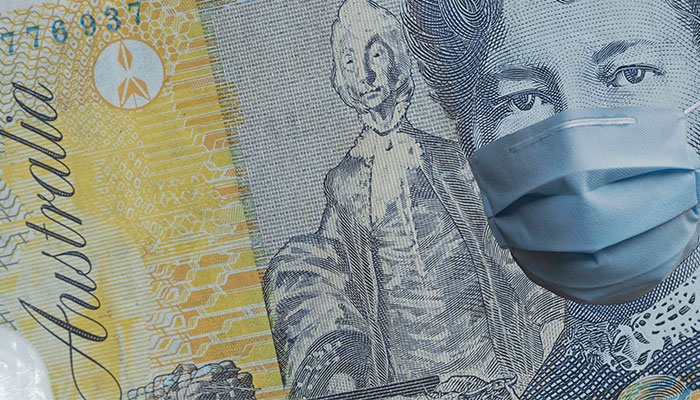In the face of the largest health shock in close to 100 years, the federal government’s budget has played a major role in steadying the economy. In essence, the government is providing cash to replace the sudden loss of spending and wage payments usually made between households and private businesses.

The road ahead: The government's budget and debt policies should evolve over time as it deals with the coronavirus shock, says Professor Orsmond.
But this sort of widespread support does not come cheaply with government debt accumulating at an exceptionally rapid rate. The Parliamentary Budget Office forecasts that with the fall in tax revenue and rise in budget spending from the measures announced to date, the Australian Government’s debt will increase by around 15-20 per cent of GDP.
With more debt-financed assistance under discussion, these estimates are likely to increase further.
Rising government debt
By itself, the rise in government debt is less of an immediate concern than commonly imagined. Australia ran a low debt level before this crisis so that it would have the flexibility to spend in adverse economic circumstances.
The gross debt-to-GDP ratio of the government stood at only 30 per cent in 2018. By comparison, the UK and US government debt ratios stood at 85 and 90 per cent, respectively.
The net result of the budget actions taken was that confidence – the rarest commodity amid any crisis – is recovering.
Furthermore, official interest rates will remain low for a period and hence so too will debt-servicing costs.
But that does not mean debt can increase without bounds. The higher the level of debt, the lower the flexibility to deal with future shocks; the more vulnerable the budget to the eventual rise in interest rates; and the lower the public’s confidence in budget management.
COVID-19 shock
The government’s budget and debt policies should therefore evolve over time as they address three distinct phases in dealing with the coronavirus shock.
The first phase was the sharp washback onto the economy as Australia got on top of the emerging health risks. The rapid quarantine led to the immediate closure of many industries – especially those providing entertainment, hospitality and travel. Other businesses also saw a sharp fall in revenue as a byproduct of social distancing rules.

Cash bailout: Failure to support companies under stress would have risked a tailspin of declining incomes, spending and employment.
Budget assistance during this phase focused on providing cash to the many companies under extreme revenue stress and to their employees stood down. The measures were unprecedented in size, broad in focus and rapid in support, reflecting the magnitude of the shock and the need to move quickly to stabilise business and household incomes.
- Please explain: who, or what, are antifa?
- New precision pictures improve diagnosis and treatment of brain diseases
Failure to do so would have risked a self-reinforcing tailspin of declining incomes, spending and employment. The net result of the budget actions taken, expensive as they were, was that confidence – the rarest commodity amid any crisis – is recovering and the worst economic scenarios have been avoided.
With the health risks now contained in most places, reopening of the businesses shuttered and the associated bounce-back in activity is under way. But bounce-back does not mean the Australian economy will return quickly to the level of output in the pre-COVID-19 days.
Not all activity will reopen soon (think international tourism) and the businesses operating face a lower level of consumption and investment demand as people remain cautious in their spending following the downturn. History suggest this second phase will last several years.
Assistance packages
The challenge for budget policy during this current phase is to shift away from the general – and expensive – support measures towards assistance to the industries and households under the most stress. Targeted packages along the lines of the recent building and arts programs are likely to become common as some industries lead and others lag the overall pace of recovery.
The large household income packages are also under review. But with broad measures of the unemployment rate over 10 per cent, youth unemployment double that rate, and history suggesting that both measures will fall only gradually, exceptional assistance of some sort will probably need to be extended beyond the current cut-off date in September.
Targeted packages along the lines of the recent building and arts programs are likely to become common as some industries lead and others lag the overall pace of recovery.
With the level of private demand and the labour market conditions recovering only gradually, we are likely to see an extended period of lower-than-usual revenues and higher-than-usual budget spending. Government debt is set to rise even further in coming years.
That touches on the third phase to deal with the crisis – the need to fund policies to boost the pace of economic growth, which would lower the debt burden as a share of GDP and lift living standards.
Bang-for-buck policies
While there are lots of ideas being bandied around – upskilling youth, infrastructure spending, tax and labour market reforms to name just a few – the truth is we know more about the ingredients than the exact recipe to maximise productivity and growth. That uncertainty suggests moving on many fronts simultaneously, which was the approach taken during the 1980s and 1990s reforms.
However, reform costs money, which bumps up against the current scarce budget revenues and rising debt levels. It will be critical to judge each budget proposal through a rigorous cost-benefit framework to ensure the best ‘bang-for-buck’ of the policies finally pursued.
In this environment, clear communication on the core challenges we face, the trade-offs involved among the various options, and community engagement on what is best and fair will be essential to address the near and longer-term consequences of this unusual health and economic shock.

David Orsmond , pictured, is Professor of Economics at Macquarie Business School. He previously spent over 25 years working at the Reserve Bank of Australia and the International Monetary Fund.



